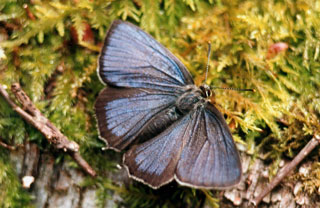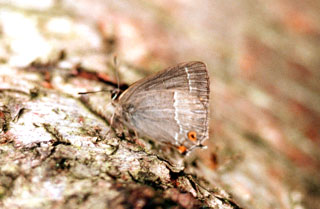Conservation status
Resident Range expanding in Britain.
UK BAP status: not listed
Butterfly Conservation priority: low
European threat status: not threatened
Protected in Northern Ireland
European/world range
The Purple Hairstreak occurs from North Africa to Southern Scandinavia
and across central Europe to Asia Minor. It is stable throughout much of
Europe but has declined in several countries and is spreading at the northern
edge of its range.
Foodplants
The Purple Hairstreak is restricted to oak trees including both the native
species, Sessile Oak (Quercus petraea)
and Pedunculate
Oak (Q. robur), and the introduced Turkey Oak (Q. cerris).
Evergreen Oak (Q. ilex) also may be used.
Habitat
Colonies of Purple Hairstreak may be found in woodlands where sufficient
oaks remain, in ancient park woodlands, associated with hedgerow and lane-side
oaks, on heathland oak scrub, oak screens along the edge of conifer plantations,
and even in towns including central London.
In groups of oaks, there is usually a favourite
tree and isolated oaks (which may be survivors from when the site was more
heavily wooded) may support colonies that have become self-contained on
the same tree for many years.
In Ireland, the butterfly tends to prefer small
oaks and colonies are often small. Adults will perch and feed on Ash and
elms in regenerating woodland because they are fast growing and out-top
oak, but oak is needed for breeding.
Identification
With wings closed, 15-20 mm
Males have an almost black upper surface to the
wings, which shimmer an iridescent deep purple as they catch the sun. The
undersides of the wings are a pale silvery grey with an irregular, wavy,
white line extending across them. The hind wing has an orange streak towards
its outer edge and there is an orange spot with a black pupil towards the
bottom corner which has a small black and white tail.
Females are very similar to the males but the
characteristic iridescent purple patches are restricted to the bases of
the forewings only.
Behaviour and life history
The Purple Hairstreak forms colonies and spends
most of its life in the canopies of oak trees but does, on occasion, come
down into the lower canopy and surrounds to feed on flowers. It spends
most of its time perched high up in the canopy, periodically leaving its
post in a dancing flight above the canopy. This butterfly overwinters as
an egg with the young caterpillars emerging in late March and pupating
at the beginning of June. Adults emerge five or six weeks later to mate
and lay their eggs on oak leaves on which the caterpillars feed.
Where to look for it
It is a very elusive butterfly which usually only
reveals itself after a long and patient search of oak canopies. It is most
likely to be found around oak trees in woodland situations but, in Plymouth,
it is most easily and frequently observed associated with oaks growing
in hedgerows.



